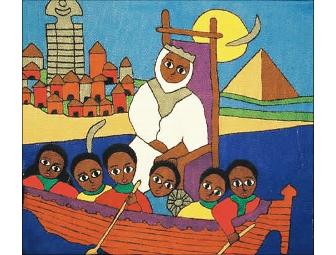Art
Queen of Sheba Ethiopian Embroidered Panel
- Item Number
- 199
- Estimated Value
- 100 USD
- Sold
- 70 USD to annettemiller
- Number of Bids
- 6 - Bid History
Item Description
This gorgeous embroidery, sewn by Ethiopian Jewish artisan Asnakew Motbaynor, depicts the journey of Ethiopian Queen of Sheba across the Red Sea for her historic meeting with King Solomon in Jerusalem. The Queen is sitting thoughtfully in her traveling throne as she is rowed past Ethiopian villages and Egyptian pyramids.
This item, donated by North Ameican Conference on Ethiopian Jewry (NACOEJ), can be used as a pillow or challah cover, or framed as a work of art.
You must read the special note, below!
Item Special Note
The NACOEJ Embroidery Program began in 1990, before Operation Solomon, when thousands of Jews were trapped in Addis Ababa, the capital of Ethiopia, waiting for permission to leave for Israel.
Since no jobs were available to them, the NACOEJ responded by developing a work program to enable the heads of Jewish households to support their families. The program utilized traditional Ethiopian skills performed by both men and women and to produce work of which they could be proud.
And so, the NACOEJ Embroidery Program was born. For 14 years, the NACOEJ Embroidery Program enabled up to 1,000 heads of Jewish households in Addis Ababa – men and women- to earn money for their families by producing beautiful works of art of which they were justly proud.
Each individual who was part of the embroidery process supported a family with his/her earnings, in a city where unemployment is very high.
 About the Program
About the Program
As members of a needleworkers’ co-op, embroiderers who were heads of households were commissioned in the NACOEJ compound in Addis Ababa to create pillow covers, challah covers, matzah covers, table runners, wall hangings, hand-woven tallitot, and custom-ordered chuppahs, as well as synagogue art. There are about 40,000 stitches in each piece, and most workers took a month to complete an embroidery. The extraordinary folk-art designs show traditional Ethiopian Jewish village scenes, illustrations of familiar Bible stories, and visions of Israel.
This program also provided employment to the purchasers of cloth and thread, the tailors who sewed the backings on, the launderers who carefully washed every piece before it left for America, those who packed the finished article for shipping, and those who kept the records and inventory.
 Though the program is now finished , NACOEJ purchased all of the embroideries that were created. The embroiderers and other workers have already been paid in full.
Though the program is now finished , NACOEJ purchased all of the embroideries that were created. The embroiderers and other workers have already been paid in full.
Donated By:
Lilith Magazine stores data...
Your support matters, so Lilith Magazine would like to use your information to keep in touch about things that may matter to you. If you choose to hear from Lilith Magazine, we may contact you in the future about our ongoing efforts.
Your privacy is important to us, so Lilith Magazine will keep your personal data secure and Lilith Magazine will not use it for marketing communications which you have not agreed to receive. At any time, you may withdraw consent by emailing Privacy@frontstream.com or by contacting our Privacy Officer. Please see our Privacy Policy found here PrivacyPolicy.

